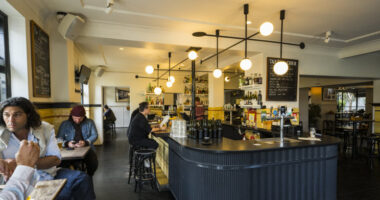I am sitting in one of the most beautiful Piazzas in Italy, Piazza Maggiore in Bologna. On a huge screen, Gene Hackman is walking across Union Square in San Francisco, which by coincidence is almost exactly the same size as the square where I’m sitting. He’s trying to record a conversation between two young lovers. The film is The Conversation, the masterpiece which Coppola sandwiched between the first two Godfathers in 1974. Coppola’s film was also inspired by Michelangelo Antonioni’s Blow Up (1966), another Italian connection. I can’t think of a better way of watching this 4K restoration, shown here as part of the 38th Cinema Ritrovato Festival, a festival dedicated to restored classics, once lost films and hidden gems. This is a carefully curated cinephilia paradise, and it doesn’t hurt that the food is the finest in Europe: mortadella, tortellini and piadine.
Here there are seasons of Marlene Dietrich’s work, including her silent films; Anatole Litvak, the Kiev-born, Russian Jew who went on to direct films in Britain, France, Germany and Hollywood and the much-underrated Italian director Pietro Germi, whose Seduced and Abandoned (1964) and Divorce Italian Style (1961) were keystones of Italian comedy but whose breadth – which is on full display here (see for instance his 1956 film The Railway Man) – has been neglected internationally.
Special guestsGuests such as Wim Wenders and Alexander Payne are on hand to introduce their own work and the work of their forebears. Wenders telling a packed audience about his film education at the hands of Anthony Mann, a fellow outsider, as he introduced Mann’s first western: The Devil’s Doorway (1950), a remarkable action film that addresses racism – albeit with Robert Taylor’s red-face performance as a Native American army veteran returning from the Civil War to face bigotry in the west. After watching George Stevens’ The Talk of the Town (1942), a frantic and gloriously entertaining Cary Grant, Jean Arthur comedy with a political slant as relevant today as then, I spoke with co-director of the festival Ehsan Khoshbakht about the contemporary resonance of much of the program.
“It’s the characteristic of great art,” says Khoshbakht. “I cannot pretend that every choice we made in terms of the selection was based on reacting to what’s happening in the world now. But these films contain all these sensibilities, so they do it in their own way. Even if you’ve programmed the film for an entirely different set of reasons, when you play it, suddenly, it becomes something else. It finds new meanings in the eye of the audience. And it is born again in the projection booths and the cinema, in front of everybody.” Some members of the audience are die-hard nitrate nuts who won’t watch a film unless it’s on celluloid. Others just want to see masterpieces like Paris, Texas (1984) and McCabe and Mrs Miller (1971) on the big screen for the first time. Then there’s a whole new generation of film lovers who are carrying the flame forward. Like Emma, a volunteer for the festival who watched Todd Browning’s Freaks (1932) for the very first time. The edition is immaculate, and she’s astonished at how ahead of its time the film is: “I expected the freaks to be the monsters.” Has Browning’s film – so controversial and subversive at the time of its release – become “politically correct”?
In these days of cinema closures and two-screening, the festival offers a tonic to the gloomsters. Ehsan agrees: “What’s so incredible is that, even with the younger audience, we’re not telling them how to behave. They already know. It seems they were just waiting for this moment: they are so ready for it. And that’s the most incredible part. They were just waiting for the opportunity to show that they care about cinema. They watch film after film after film and discuss these films with friends.” The film festival has expanded in recent years with a newly restored cinema – the Modernismo, a work of art in itself – catering to increased demand. Bologna also hosts the Biografilm Festival, a showcase for biographical documentaries, as well being the home to the Immagine Ritrovato, a laboratory of film restoration which is now an internationally recognized center of excellence. For Ehsan, there is a sense of mission: “The key question is not for this festival but for the entire film community around the world. How can we provide our audiences, especially the younger ones, with places like this? So that they trust the programming and the quality of the projection? When we do, they will immerse themselves in the experience.” The Bologna Cinema





